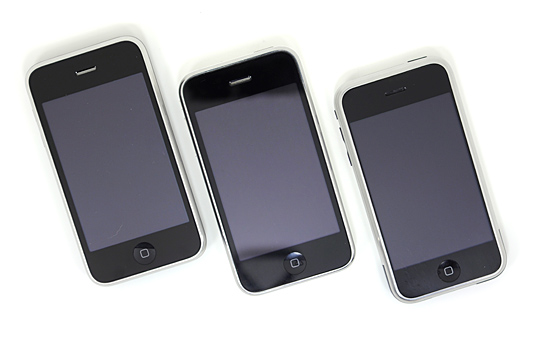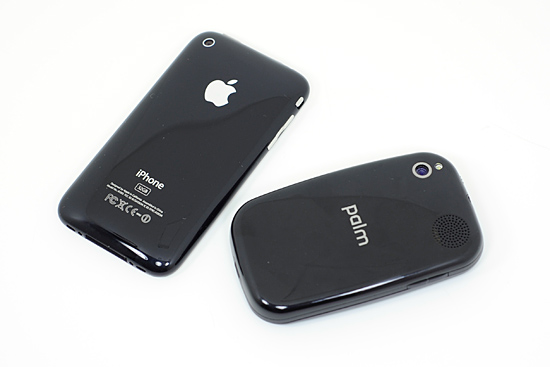Understanding the iPhone 3GS
by Anand Lal Shimpi on July 7, 2009 12:00 AM EST- Posted in
- Smartphones
- Mobile
I get some sort of odd satisfaction when Apple releases a product whose fundamental improvement is a new CPU. It happened when Apple first announced the MacBook Air, and it happened once more with the new iPhone 3GS:

From Left to Right: iPhone 3GS, iPhone 3G, iPhone
From a distance you can’t tell it apart from the iPhone 3G, which itself was arguably a step back in design from the original aluminum iPhone. But Apple products only sell because they look pretty right? How on earth would Apple ever justify selling an iPhone 3GS whose fundamental improvement is inside its pretty plastic?

To make matters worse, Apple has trained its users to expect significant changes in styling and UI on a regular basis. Just look at the progression of Mac OS X over the past several years. However, even with the latest iPhone OS release and significant technological pressure from Palm, the UI remains unchanged.
Competing against Microsoft and the other smartphone makers was pretty easy. Just do what they did, only better. But here we have the latest iPhone and it’s already behind the Palm Pre in a number of key features. Uhoh.
Yes, the S stands for Speed with the new iPhone 3GS but is that enough to keep this train rolling? We needed speed last year with the iPhone 3G, and all we got was a faster modem and lower battery life. Now we need multitasking support and we finally get a faster processor. Apple seems to be one step behind in the needs department, which is the perfect recipe for a company like Palm to step in and surprise.

Stepping away from the broader picture for a moment, Apple heads and haters alike can both appreciate the technology behind the 3GS, because the transition itself echoes what we’ve seen happen in the PC industry over the past two decades.
In my first iPhone 3GS article I compared the CPU upgrade to what we saw going from the 486 to Intel’s Pentium processor in the mid 1990s. Perhaps we need a quick refresher in CPU architecture? I’ll see if I can keep this succinct.










60 Comments
View All Comments
iwodo - Thursday, July 9, 2009 - link
Would really love Anand digg deeper and give us some more info. The info i could find for Atom, has 47 Million transistors. Ars report 40% of it is cache, while others report the core is 13.7 million. The previous iPhone article Jarred Walton commented that x86 decoder no longer matters because 1.5 - 2 million transistors inside a billions transistor CPU is negligible. However in Mobile space, 2M inside a 13.7M is nearly 15%. Not to mention other transistor used that is needed for this decoding.The space required for Atom is 25mm2 on a 45NM ( Including All Cache) . Cortex A8 require 9mm2 ( dont know how many cache ) on 65nm.
What is interesting is how Intel manage to squeeze the north bridge inside the Atom CPU ( more transistors ) while making the Die Smaller. ( i dont know if Intel slides were referring to the total package size or the die size itself ).
snookie - Thursday, July 9, 2009 - link
The Pre hardware, as in case, screen, keyboard is terrible. Cheap, plasticky and breaking left and right on people. If Palm survives long enough to get to Verizon etc Here's hoping they come out with better hardware soon. I've used Blackberries for year but I see no need for a physical keyboard. With the new iPhone widescreen keyboard I type with both thumbs very quickly and I have big hands.snookie - Thursday, July 9, 2009 - link
Jason, Apple has in fact agreed to using mini-usb as a standard. As if that is really a reason to buy a phone or not.To say Apple never changes shows no knowledge of the history of Apple, even their recent history.
Itaintrite - Wednesday, July 8, 2009 - link
Heh, it's funny how you say that you can't just look at clock speed, then followed with "the 528MHz processor in the iPod Touch is no where near as fast as the 600MHz processor in the iPhone 3GS." Heh.Anonymous Freak - Wednesday, July 8, 2009 - link
I want my punch and pie!Or a lollipop.
Good review, I could feel your hunger pangs toward both Palm and Apple toward the end...
monomer - Wednesday, July 8, 2009 - link
Regarding Anand's comments about Android phones needing an upgraded CPU, rumors are that the upcoming Sony Xperia Rachael will be sporting a 1GHz Qualcomm Snapdragon processor (ARM Cortex A8 derivative). Would love to find out the details of this phone when they become available.http://www.engadget.com/2009/07/04/sony-ericsson-r...">http://www.engadget.com/2009/07/04/sony...chael-an...
Affectionate-Bed-980 - Thursday, July 9, 2009 - link
Well I'd like to see Anand's experience with Android phones. What is it, just G1? Look at the new Hero or even G2. What about the Samsung i7500? Sorry I'm afraid that the limited nature of cell phone selection in the US makes it VERY HARD to review cell phones well here. I haven't seen a good cell phone site that's by people in the US and from the US only. Phone Arena, Mobile Burn, Phonescoop, GSM Arena, It seems the international guys get a LOT more exposure, and this is why I feel like Anand's comments about phones in general makes him sound inexperienced which I can certainly bet is the case.If you limit yourself to only carrier offered phones, then I don't think you can make accurate assessments about manufacturers like Nokia or certain OS phones like WinMo or Symbian or even Android unless the US starts offering more of what the world considers top notch popular phones.
Affectionate-Bed-980 - Wednesday, July 8, 2009 - link
N97 specs should be 434 MHz ARM11 not 424...Affectionate-Bed-980 - Wednesday, July 8, 2009 - link
BTW I don't believe you should be commenting about the N97. Gizmodo is heavily biased towards iPhones and unless you yourself Anand uses some Symbian S60 phones with detail, I don't really think you should join in the S60 bashing. I think a lot of us Symbian users AGREE that the platform needs to improve, but considering we were like ZOMG434MHZFAIL, the N97 is not bad in response time if you look at a few videos. The UI exceeded a lot of expectations amongst the Symbian crowd. If anything why don't you throw the Samsung i8910 Omnia HD in there instead? That has a Cortex A8 and uses Symbian S60v5 (not to mention has been out longer than the N97). The other S60v5 phone to come out is the Sony Satio which also uses a Cortex A8.You might as well comment on why Cortex A8 isn't being implemented in all new phones. WinMo phones are still on ARM11, and even HTC's newest announcements are ARMv7 chips. The iPhone doesn't define what high end is. Because if you want to point out that its unacceptable to have a ARMv7 chip in an N97, then it's just as unacceptable for the iPhone not to have a 5MP camera and multitasking.
straubs - Wednesday, July 8, 2009 - link
1. It IS unacceptable for any flagship phone to use ARM11. The iPhone, Pre, and Omnia HD (as you pointed out) all use it, so why wouldn't Nokia put it in it's $700 N-series flagship? It doesn't make sense. I'm surprised he didn't mention the crappy screen on the N97.2. He did comment on how the iPhone needs multi-tasking and how much he missed the Pre's implementation of it.
3. Doesn't everyone at this point agree that the number of megapixels in a phone camera is not a huge deal, considering the size of the sensor and optics? I would guess the N97 pictures are better than those from the the 3GS, but nothing like the jump from an ARM11 or A8.